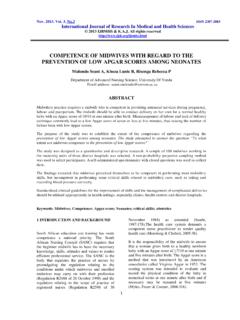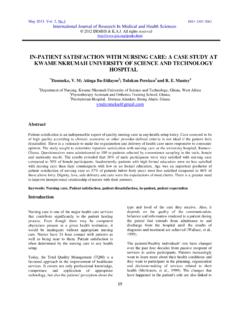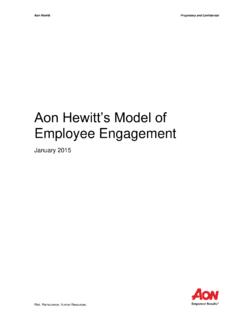Transcription of A CRITICAL REVIEW OF LITERATURE ON EMPLOYEE …
1 Jan. 2016. Vol. 6, ISSN 2307-227X International Journal of Research In Social Sciences 2013-2016 IJRSS & All rights reserved 1 A CRITICAL REVIEW OF LITERATURE ON EMPLOYEE ENGAGEMENT CONCEPT 1 ONESMUS KAMAU AND 2
2 MUATHE SMA (PHD) 1 PhD Student School of Business Kenyatta University 2 Associate Dean School of Business Kenyatta University ABSTRACT EMPLOYEE engagement has continued to receive increased attention in the recent past. Interest in this concept has been encouraged by the fact that it is not just enough for EMPLOYEE to report to work but also to be passionate about the work. Studies have also shown that when employees are engaged their productivity increase. This study carries out a CRITICAL REVIEW of LITERATURE on EMPLOYEE engagement concept in order to establish both conceptual and empirical gaps.
3 Key words: EMPLOYEE Engagement, Leadership, Social Support, Job Characteristics, Communication 1. BACKGROUND OF THE STUDY Employees are considered as an important resource in any organization. Globally there been an increase in talent war and therefore each organization has to ensure that apart from attracting the best talent they are able to retain these talented employees. Retaining employees in an organization is however also not enough as one may have the best talent but the employees may not be passionate about their work.
4 Pandita and Bedarkar (2014) notes that one of the toughest challenges facing Chief Executive officers ( ), Human Resources (HR) and business leaders of many organizations is to ensure that when their employees reports to work every day they not only do it physically but mentally and emotionally. This means that organization must ensure that their employees are engaged so that they are able to contribute positively towards achieving the organizational goals. Kahn(1990) who is considered as the father of EMPLOYEE engagement movement defines it as harnessing of organization members selves to their work roles; in engagement people EMPLOYEE and express themselves physically, cognitively and emotionally during role performances (pg 694).
5 By this Kahn implied that an EMPLOYEE has to be present both physically and psychologically when performing organizational roles. Meere (2005) describes three levels of engagement: a) Engaged-Employees who work with passion and feel a profound connection to their organization .They drive innovation and move the organization forward. b) Not engaged- employees who attend and participate at work but are time serving and put no passion or energy into their work and, c) Disengaged employees who are unhappy at work and who act out their unhappiness at work.
6 According to Meere (2005) these employees undermine the work of their engaged colleagues every time. It is therefore important for an organization to assess the levels of engagement of its employees so that they can take the necessary intervention to boost morale and productivity of their employees. Several studies have confirmed that there is actually a relationship between EMPLOYEE engagement and organization performance. For example study by Tower, Perin, USA (2003, 2007) linked the same to customer impact and financial results, Harter, Schmidt and Hayes (2002) showed a link to productivity and profitability while a recent Kroth and Boverie (2013) noted that engaged employees are passionate about their work which results to excitement ,enthusiasm and productivity.
7 Though there is this link between EMPLOYEE engagement and organization performance, studies have Jan. 2016. Vol. 6, ISSN 2307-227X International Journal of Research In Social Sciences 2013-2016 IJRSS & All rights reserved 2 also shown that in most organizations.
8 Only a few employees are actually engaged. A study by Gallup in different parts of the world on level of engagement provides an alarming scenario of low engagement levels in different countries. For example Gallup (2004) revealed the following: in Thailand only 12% of the employees were engaged while 82% were actively disengaged and 6% disengaged. In Australia , China ,Japan , New Zealand and Singapore similar Gallup studies have found the levels of engagement to be 18%, 12%, 9%, 7%, and 9% respectively ( as cited in Kular 2007).
9 A recent study by a global consulting firm found that four employees out of ten are not engaged worldwide ( aon hewitt report 2012). This statistics show need for organization to look at EMPLOYEE engagement with a lot of weight since boosting employees engagement levels can give an organization a comparative advantage over the others. There is therefore need to identify the key drivers of EMPLOYEE engagement and initiate necessary interventions in order to improve engagement levels among the employees.
10 2 LITERATURE REVIEW Though there are many factors that influence EMPLOYEE engagement this study paper reviews a few from previous researches. Factors discussed are leadership, social support, communication and job characteristics Leadership Ologbo and Saudah (2011), note that employees need to be confident with their organization and this confidence can be build through reliability of the leadership. Trust in leader, support from the leader, and creating a blame-free are considered as components of psychological safety, a condition proposed by Kahn, which leads to EMPLOYEE engagement (Xu and Thomas Cooper, 2010).



